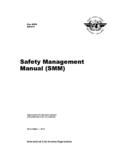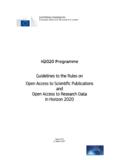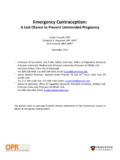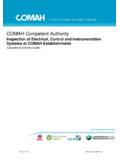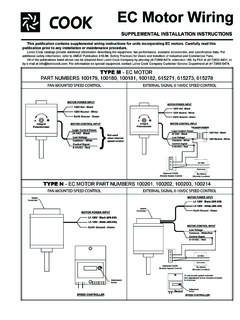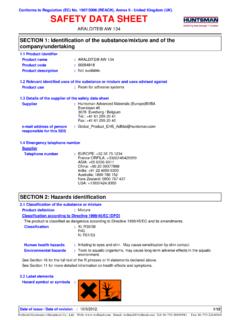Transcription of I REGULATIONS - SKYbrary
1 I(Acts adopted under the EC Treaty/Euratom Treaty whose publication is obligatory)REGULATIONSCOMMISSION REGULATION (EC) No 859/2008of 20 August 2008amending Council Regulation (EEC) No 3922/91 as regards common technicalrequirements andadministrative procedures applicable to commercial transportation by aeroplaneTHE COMMISSION OF THE EUROPEAN COMMUNITIES,Having regard to the Treaty establishing the EuropeanCommunity,Having regard to Council Regulation (EEC) No 3922/91 of16 December 1991 on the harmonisation of technical require-ments and administrative procedures in the field of civil avia-tion (1), and in particular Article 11(1) thereof,Whereas:(1)Regulation (EEC) No 3922/91 provides that the Commis-sion shall adopt the amendments to the common techni-cal requirements and administrative procedures listed inAnnex III thereto which are necessitated by scientific andtechnical progress.
2 (2)Annex III to Regulation (EEC) No 3922/91 is based on a setof harmonised rules adopted by the Joint Aviation Authori-ties (JAA) called Joint Aviation Requirements for Commer-cial Air Transportation (Aeroplanes) (JAR-OPS 1).(3)Regulation (EEC) 8/2008 (2).updated Annex III in order toreflect the amendments made to JAR-OPS since 1 January2005 (Amendments 9 to 12) before the date on which thatAnnex will become applicable (16 July 2008)(4)On the basis of further work conducted by the EuropeanAir Safety Agency, and pending the adoption of the imple-menting REGULATIONS provided in Regulation (EC) 8/2008,that Annex should be amended again in order to includecertain detailed technical and operational requirementsrelating to the most crucial safety elements of that Annex.
3 (5)These new requirements should be applicable withoutdelay. However, a lead time is needed by the industry andthe authorities for the implementation of complex provi-sions pertaining to all weather operations and cabin crewtraining;(6)Annex III to Regulation (EEC) No 3922/91 should there-fore be amended accordingly.(7)The measures provided for in this Regulation are in accor-dance with the opinion of the Air Safety Committee estab-lished by Article 12 of Regulation (EEC) No 3922/91,HAS ADOPTED THIS REGULATION:Article 1 Annex III to Council Regulation (EEC) No 3922/1991 is replacedby the Annex to this 21.
4 This Regulation shall enter into force on the day of its pub-lication in theOfficial Journal of the European Union.(1) OJ L 373, , p. 4.(2) OJ L 10, , p. Journal of the European UnionL 254/12. The provisions of the Annex of this Regulation concern-ing OPS , OPS , OPS , Appendix 1 toOPS , Appendix 1 to OPS , Appendix 1 to and Appendix 3 to OPS shallapply from 16 July The provisions of the Annex of this Regulation concerningOPS , OPS , OPS , OPS , OPS ,OPS , Appendix 1 to OPS , Appendix 1 to OPS ,Appendix 1 to OPS and Appendix 1 to OPS shallapply from 16 July Pending the application of the provisions referred to inparagraphs 2 and 3.
5 The corresponding provisions of the Annexto Regulation (EEC) 8/2008 shall continue to Regulation shall be binding in its entirety and directly applicable in all Member at Brussels, 20 August the CommissionAntonio TAJANIVice-PresidentL 254/2 ENOfficial Journal of the European ANNEXIIIC ommon technical requirements and administrative procedures applicable to commercial transportation by aircraftOPS 1: Commercial air transportation (aeroplanes)Contents (General layout)SUBPART A Applicability and definitionsSUBPART B GeneralSUBPART C Operator certification and supervisionSUBPART D Operational proceduresSUBPART E All weather operationsSUBPART F Performance generalSUBPART G Performance Class ASUBPART H Performance Class BSUBPART I Performance Class CSUBPART J Mass and balanceSUBPART K Instruments and equipmentSUBPART L Communication and navigation equipmentSUBPART M Aeroplane maintenanceSUBPART N Flight crewSUBPART O Cabin crewSUBPART P Manuals.
6 Logs and recordsSUBPART Q Flight and duty time limitations and rest requirementsSUBPART R Transport of dangerous goods by airSUBPART S Journal of the European UnionL 254/3 SUBPART AAPPLICABILITY AND DEFINITIONSOPS Part 1 prescribes requirements applicable to the operation of any civil aeroplane for the purpose of commercial air trans-portation by any operator whose principal place of business and, if any, registered office is in a Member State, hereafter calledoperator. OPS 1 does not apply:1. to aeroplanes when used in military, customs and police services; nor2.
7 To parachute dropping and fire-fighting flights, and to associated positioning and return flights in which the personscarried are those who would normally be carried on parachute dropping or fire-fighting; nor3. to flights immediately before, during, or immediately after an aerial work activity provided these flights are connectedwith that aerial work activity and in which, excluding crew members, no more than 6 persons indispensable to the aerialwork activity are (a) For the purpose of this Annex:1. accepted/acceptable means not objected to by the Authority as suitable for the purpose approved (by the Authority) means documented (by the Authority) as suitable for the purpose Master minimum equipment list (MMEL) means a master list (including apreamble)
8 Appropriate to an aircrafttype which determines those instruments, items of equipment or functionsthat, while maintaining the level ofsafety intended in the applicable airworthiness certification specifications, may temporarily be inoperative eitherdue to the inherent redundancy of the design, and/or due to specified operational and maintenance procedures,conditions and limitations, and in accordance with the applicable procedures for Continued Minimum equipment list (MEL) means a list (including a preamble) which provides for the operation of aircraft,under specified conditions, with particular instruments, items of equipment or functions inoperative at the com-mencement of flight.
9 This list is prepared by the operator for his own particular aircraft taking account of theiraircraft definition and the relevant operational and maintenance conditions in accordance with a procedureapproved by the Authority.(b) Part M and Part 145 as referred to in this Annex are those of Commission Regulation (EC) No 2042/2003 (1).(1) OJ L 315, , p. 254/4 ENOfficial Journal of the European BGENERALOPS (a) An operator shall not operate an aeroplane for the purpose of commercial air transportation other than in accordancewith OPS Part 1.
10 For operations of Performance Class B aeroplanes, alleviated requirements can be found in Appen-dix 1 to OPS (a).(b) An operator shall comply with the applicable retroactive airworthiness requirements for aeroplanes operated for thepurpose of commercial air transportation.(c) Each aeroplane shall be operated in compliance with the terms of its Certificate of Airworthiness and within theapproved limitations contained in its Aeroplane Flight Manual.(d) All synthetic training devices (STD), such as flight simulators or flight training devices (FTD), replacing an aeroplanefor training and/or checking purposes are to be qualified in accordance with the requirements applicable to synthetictraining devices.
